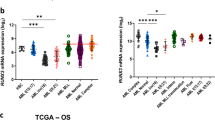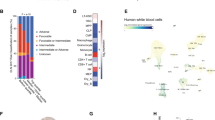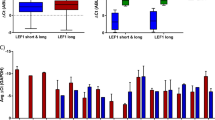Abstract
BCOR is a component of a variant Polycomb group repressive complex 1 (PRC1). Recently, we and others reported recurrent somatic BCOR loss-of-function mutations in myelodysplastic syndrome and acute myelogenous leukemia (AML). However, the role of BCOR in normal hematopoiesis is largely unknown. Here, we explored the function of BCOR in myeloid cells using myeloid murine models with Bcor conditional loss-of-function or overexpression alleles. Bcor mutant bone marrow cells showed significantly higher proliferation and differentiation rates with upregulated expression of Hox genes. Mutation of Bcor reduced protein levels of RING1B, an H2A ubiquitin ligase subunit of PRC1 family complexes and reduced H2AK119ub upstream of upregulated HoxA genes. Global RNA expression profiling in murine cells and AML patient samples with BCOR loss-of-function mutation suggested that loss of BCOR expression is associated with enhanced cell proliferation and myeloid differentiation. Our results strongly suggest that BCOR plays an indispensable role in hematopoiesis by inhibiting myeloid cell proliferation and differentiation and offer a mechanistic explanation for how BCOR regulates gene expression such as Hox genes.
This is a preview of subscription content, access via your institution
Access options
Subscribe to this journal
Receive 12 print issues and online access
$259.00 per year
only $21.58 per issue
Buy this article
- Purchase on Springer Link
- Instant access to full article PDF
Prices may be subject to local taxes which are calculated during checkout







Similar content being viewed by others
References
Huynh KD, Fischle W, Verdin E, Bardwell VJ . BCoR, a novel corepressor involved in BCL-6 repression. Genes Dev 2000; 14: 1810–1823.
Cattoretti G, Pasqualucci L, Ballon G, Tam W, Nandula SV, Shen Q et al. Deregulated BCL6 expression recapitulates the pathogenesis of human diffuse large B cell lymphomas in mice. Cancer Cell 2005; 7: 445–455.
Hatzi K, Jiang Y, Huang C, Garrett-Bakelman F, Gearhart MD, Giannopoulou EG et al. A hybrid mechanism of action for BCL6 in B cells defined by formation of functionally distinct complexes at enhancers and promoters. Cell Rep 2013; 4: 578–588.
Zhang J, Benavente CA, McEvoy J, Flores-Otero J, Ding L, Chen X et al. A novel retinoblastoma therapy from genomic and epigenetic analyses. Nature 2012; 481: 329–334.
Pugh TJ, Weeraratne SD, Archer TC, Pomeranz Krummel DA, Auclair D, Bochicchio J et al. Medulloblastoma exome sequencing uncovers subtype-specific somatic mutations. Nature 2012; 488: 106–110.
Pierron G, Tirode F, Lucchesi C, Reynaud S, Ballet S, Cohen-Gogo S et al. A new subtype of bone sarcoma defined by BCOR-CCNB3 gene fusion. Nat Genet 2012; 44: 461–466.
Totoki Y, Tatsuno K, Yamamoto S, Arai Y, Hosoda F, Ishikawa S et al. High-resolution characterization of a hepatocellular carcinoma genome. Nat Genet 2011; 43: 464–469.
Yamamoto Y, Abe A, Emi N . Clarifying the impact of polycomb complex component disruption in human cancers. Mol Cancer Res 2014; 12: 479–484.
Damm F, Chesnais V, Nagata Y, Yoshida K, Scourzic L, Okuno Y et al. BCOR and BCORL1 mutations in myelodysplastic syndromes and related disorders. Blood 2013; 122: 3169–3177.
Grossmann V, Tiacci E, Holmes AB, Kohlmann A, Martelli MP, Kern W et al. Whole-exome sequencing identifies somatic mutations of BCOR in acute myeloid leukemia with normal karyotype. Blood 2011; 118: 6153–6163.
Kulasekararaj AG, Jiang J, Smith AE, Mohamedali AM, Mian S, Gandhi S et al. Somatic mutations identify a subgroup of aplastic anemia patients who progress to myelodysplastic syndrome. Blood 2014; 124: 2698–2704.
Yoshizato T, Dumitriu B, Hosokawa K, Makishima H, Yoshida K, Townsley D et al. Somatic mutations and clonal hematopoiesis in aplastic anemia. N Engl J Med 2015; 373: 35–47.
Ng D, Thakker N, Corcoran CM, Donnai D, Perveen R, Schneider A et al. Oculofaciocardiodental and Lenz microphthalmia syndromes result from distinct classes of mutations in BCOR. Nat Genet 2004; 36: 411–416.
Wamstad JA, Corcoran CM, Keating AM, Bardwell VJ . Role of the transcriptional corepressor Bcor in embryonic stem cell differentiation and early embryonic development. PLoS One 2008; 3: e2814.
Sanchez C, Sanchez I, Demmers JA, Rodriguez P, Strouboulis J, Vidal M . Proteomics analysis of Ring1B/Rnf2 interactors identifies a novel complex with the Fbxl10/Jhdm1B histone demethylase and the Bcl6 interacting corepressor. Mol Cell Proteomics 2007; 6: 820–834.
Gearhart MD, Corcoran CM, Wamstad JA, Bardwell VJ . Polycomb group and SCF ubiquitin ligases are found in a novel BCOR complex that is recruited to BCL6 targets. Mol Cell Biol 2006; 26: 6880–6889.
Gao Z, Zhang J, Bonasio R, Strino F, Sawai A, Parisi F et al. PCGF homologs, CBX proteins, and RYBP define functionally distinct PRC1 family complexes. Mol Cell 2012; 45: 344–356.
Lewis EB . A gene complex controlling segmentation in Drosophila. Nature 1978; 276: 565–570.
Jaenisch R, Young R . Stem cells, the molecular circuitry of pluripotency and nuclear reprogramming. Cell 2008; 132: 567–582.
Margueron R, Reinberg D . The Polycomb complex PRC2 and its mark in life. Nature 2011; 469: 343–349.
Sparmann A, van Lohuizen M . Polycomb silencers control cell fate, development and cancer. Nat Rev Cancer 2006; 6: 846–856.
Simon JA, Kingston RE . Occupying chromatin: Polycomb mechanisms for getting to genomic targets, stopping transcriptional traffic, and staying put. Mol Cell 2013; 49: 808–824.
de Napoles M, Mermoud JE, Wakao R, Tang YA, Endoh M, Appanah R et al. Polycomb group proteins Ring1A/B link ubiquitylation of histone H2A to heritable gene silencing and X inactivation. Dev Cell 2004; 7: 663–676.
Wang H, Wang L, Erdjument-Bromage H, Vidal M, Tempst P, Jones RS et al. Role of histone H2A ubiquitination in Polycomb silencing. Nature 2004; 431: 873–878.
Simon JA, Kingston RE . Mechanisms of polycomb gene silencing: knowns and unknowns. Nat Rev Mol Cell Biol 2009; 10: 697–708.
Cao R, Tsukada Y, Zhang Y . Role of Bmi-1 and Ring1A in H2A ubiquitylation and Hox gene silencing. Mol Cell 2005; 20: 845–854.
Chua SW, Vijayakumar P, Nissom PM, Yam CY, Wong VV, Yang H . A novel normalization method for effective removal of systematic variation in microarray data. Nucleic Acids Res 2006; 34: e38.
Junco SE, Wang R, Gaipa JC, Taylor AB, Schirf V, Gearhart MD et al. Structure of the polycomb group protein PCGF1 in complex with BCOR reveals basis for binding selectivity of PCGF homologs. Structure 2013; 21: 665–671.
Brown AL, Wilkinson CR, Waterman SR, Kok CH, Salerno DG, Diakiw SM et al. Genetic regulators of myelopoiesis and leukemic signaling identified by gene profiling and linear modeling. J Leukoc Biol 2006; 80: 433–447.
Gery S, Gombart AF, Yi WS, Koeffler C, Hofmann WK, Koeffler HP . Transcription profiling of C/EBP targets identifies Per2 as a gene implicated in myeloid leukemia. Blood 2005; 106: 2827–2836.
de Boer J, Williams A, Skavdis G, Harker N, Coles M, Tolaini M et al. Transgenic mice with hematopoietic and lymphoid specific expression of Cre. Eur J Immunol 2003; 33: 314–325.
Ross K, Sedello AK, Todd GP, Paszkowski-Rogacz M, Bird AW, Ding L et al. Polycomb group ring finger 1 cooperates with Runx1 in regulating differentiation and self-renewal of hematopoietic cells. Blood 2012; 119: 4152–4161.
Faber J, Krivtsov AV, Stubbs MC, Wright R, Davis TN, van den Heuvel-Eibrink M et al. HOXA9 is required for survival in human MLL-rearranged acute leukemias. Blood 2009; 113: 2375–2385.
Hess JL, Bittner CB, Zeisig DT, Bach C, Fuchs U, Borkhardt A et al. c-Myb is an essential downstream target for homeobox-mediated transformation of hematopoietic cells. Blood 2006; 108: 297–304.
Venezia TA, Merchant AA, Ramos CA, Whitehouse NL, Young AS, Shaw CA et al. Molecular signatures of proliferation and quiescence in hematopoietic stem cells. PLoS Biol 2004; 2: e301.
Zeller KI, Jegga AG, Aronow BJ, O'Donnell KA, Dang CV . An integrated database of genes responsive to the Myc oncogenic transcription factor: identification of direct genomic targets. Genome Biol 2003; 4: R69.
Lanotte M, Martin-Thouvenin V, Najman S, Balerini P, Valensi F, Berger R . NB4, a maturation inducible cell line with t(15;17) marker isolated from a human acute promyelocytic leukemia (M3). Blood 1991; 77: 1080–1086.
Gallagher R, Collins S, Trujillo J, McCredie K, Ahearn M, Tsai S et al. Characterization of the continuous, differentiating myeloid cell line (HL-60) from a patient with acute promyelocytic leukemia. Blood 1979; 54: 713–733.
Benita Y, Cao Z, Giallourakis C, Li C, Gardet A, Xavier RJ . Gene enrichment profiles reveal T-cell development, differentiation, and lineage-specific transcription factors including ZBTB25 as a novel NF-AT repressor. Blood 2010; 115: 5376–5384.
Bagger FO, Rapin N, Theilgaard-Monch K, Kaczkowski B, Thoren LA, Jendholm J et al. HemaExplorer: a database of mRNA expression profiles in normal and malignant haematopoiesis. Nucleic Acids Res 2013; 41: D1034–D1039.
Ben-Porath I, Thomson MW, Carey VJ, Ge R, Bell GW, Regev A et al. An embryonic stem cell-like gene expression signature in poorly differentiated aggressive human tumors. Nat Genet 2008; 40: 499–507.
Jaatinen T, Hemmoranta H, Hautaniemi S, Niemi J, Nicorici D, Laine J et al. Global gene expression profile of human cord blood-derived CD133+ cells. Stem Cells 2006; 24: 631–641.
Douglas D, Hsu JH, Hung L, Cooper A, Abdueva D, van Doorninck J et al. BMI-1 promotes ewing sarcoma tumorigenicity independent of CDKN2A repression. Cancer Res 2008; 68: 6507–6515.
Bach C, Buhl S, Mueller D, Garcia-Cuellar MP, Maethner E, Slany RK . Leukemogenic transformation by HOXA cluster genes. Blood 2010; 115: 2910–2918.
Thorsteinsdottir U, Mamo A, Kroon E, Jerome L, Bijl J, Lawrence HJ et al. Overexpression of the myeloid leukemia-associated Hoxa9 gene in bone marrow cells induces stem cell expansion. Blood 2002; 99: 121–129.
Thorsteinsdottir U, Sauvageau G, Hough MR, Dragowska W, Lansdorp PM, Lawrence HJ et al. Overexpression of HOXA10 in murine hematopoietic cells perturbs both myeloid and lymphoid differentiation and leads to acute myeloid leukemia. Mol Cell Biol 1997; 17: 495–505.
Endoh M, Endo TA, Endoh T, Isono K, Sharif J, Ohara O et al. Histone H2A mono-ubiquitination is a crucial step to mediate PRC1-dependent repression of developmental genes to maintain ES cell identity. PLoS Genet 2012; 8: e1002774.
Anastasi J, Feng J, Le Beau MM, Larson RA, Rowley JD, Vardiman JW . Cytogenetic clonality in myelodysplastic syndromes studied with fluorescence in situ hybridization: lineage, response to growth factor therapy, and clone expansion. Blood 1993; 81: 1580–1585.
Raza A, Gezer S, Mundle S, Gao XZ, Alvi S, Borok R et al. Apoptosis in bone marrow biopsy samples involving stromal and hematopoietic cells in 50 patients with myelodysplastic syndromes. Blood 1995; 86: 268–276.
Raza A, Galili N . The genetic basis of phenotypic heterogeneity in myelodysplastic syndromes. Nat Rev Cancer 2012; 12: 849–859.
Acknowledgements
We thank Dimitris Kioussis for sharing the Vav-iCre allele. This work was funded by the National Institutes of Health, USA (NIH; Grant No. R01CA026038-35 (HPK) and 5R01CA071540 (VJB)), the Singapore Ministry of Health’s National Medical Research Council (NMRC) under its Singapore Translational Research (STaR) Investigator Award to HPK and the NMRC Centre Grant awarded to National University Cancer Institute of Singapore, the National Research Foundation Singapore and the Singapore Ministry of Education under its Research Centres of Excellence initiatives. Further thanks is given to Reuben Yeroushalmi, Blanche and Steven Koegler. Additional funding came from the Minnesota Masonic Charities, the University of Minnesota OVPR and the Leukemia Research Fund (VJB).
Author information
Authors and Affiliations
Corresponding author
Ethics declarations
Competing interests
The authors declare no conflict of interest.
Additional information
Supplementary Information accompanies this paper on the Leukemia website
Rights and permissions
About this article
Cite this article
Cao, Q., Gearhart, M., Gery, S. et al. BCOR regulates myeloid cell proliferation and differentiation. Leukemia 30, 1155–1165 (2016). https://doi.org/10.1038/leu.2016.2
Received:
Revised:
Accepted:
Published:
Issue Date:
DOI: https://doi.org/10.1038/leu.2016.2
This article is cited by
-
Heterozygous variants in GATA2 contribute to DCML deficiency in mice by disrupting tandem protein binding
Communications Biology (2022)
-
Dynamics of epigenetic regulator gene BCOR mutation and response predictive value for hypomethylating agents in patients with myelodysplastic syndrome
Clinical Epigenetics (2021)
-
Bcor deficiency perturbs erythro-megakaryopoiesis and cooperates with Dnmt3a loss in acute erythroid leukemia onset in mice
Leukemia (2021)
-
BCOR-coupled H2A monoubiquitination represses a subset of androgen receptor target genes regulating prostate cancer proliferation
Oncogene (2020)
-
Pathogenesis and biomarkers of natural killer T cell lymphoma (NKTL)
Journal of Hematology & Oncology (2019)



